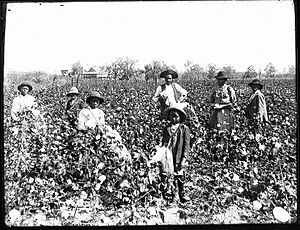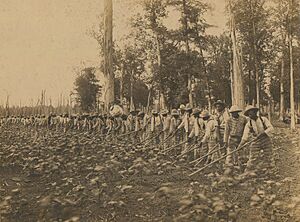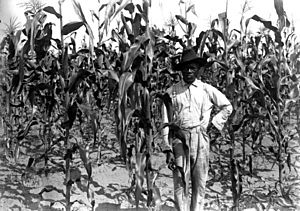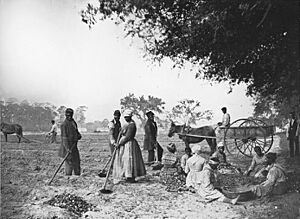African-American history of agriculture in the United States facts for kids
African Americans have played a huge part in farming history in the United States. For a long time, many were forced to work as enslaved people on large farms called plantations, especially in the Southern states. They grew crops like cotton and tobacco.
After slavery ended around 1863-1865, most Black people stayed in farming. But they were often very poor sharecroppers, meaning they rented land and paid with a share of their crops. They rarely owned their own land. Later, many began to move to cities in what was called the Great Migration. Today, about 40,000 African Americans are farmers.
Contents
History
The 1700s
In the 1700s, plantation owners brought many enslaved people from Africa, the Caribbean, and Mexico. These people were forced to work on large farms called plantations, mostly growing cotton and tobacco. Women and children were also forced to work on these farms. The growth of Slavery in the United States is closely linked to how much plantation farming grew.
Many plantation owners actually depended on the farming knowledge that enslaved Africans brought with them. A great example is how rice was grown in South Carolina. Enslaved people from West Africa knew how to grow a specific type of rice, Oryza glaberrima. This special knowledge helped South Carolina become a major rice producer.
Even while enslaved, African Americans found ways to get more food. They grew their own small gardens, often near their cabins or in hidden parts of the plantation. These gardens helped them in three ways: they provided food, a little bit of money, and plants for medicine. If they grew more than they needed, they could sell the extra crops. This gave them some control over their lives.
The 1800s
Before the Civil War
Before 1865, most Black farmworkers in the South were enslaved. However, a smaller number were free and worked for others or owned their own farms. In South Carolina, about 400 free Black farmers lived near Charleston. Their lives were similar to their poor white neighbors. They focused on growing food for their families first. They also tried to get help from wealthy white people to survive.
Virginia had many free Black people. By 1860, about 58,000 free Black people lived there, mostly in rural areas. About one in eight Black people in Virginia was free, while the rest were enslaved. Free Black people faced many strict laws. They could not vote, testify in court, or go to schools. New ex-slaves who became free often had to leave the state.
However, free Black people could own property. In 1860, they owned and ran 1,202 small farms. Some rich white landowners hired them for cash, especially during harvest or when planting tobacco. In 1853, some people wanted to force all free Black people out of Virginia. But important white landowners stopped this plan because they needed the free Black people's labor. For the free Black people, getting small amounts of cash was helpful. Getting old clothes, used tools, or young animals instead of cash was also useful. Most importantly, it was vital for their survival to be helpful to powerful white neighbors.
After slavery ended
After slavery ended and the Thirteenth Amendment was passed, Black people were legally free. But most had no money or land. This led them into new difficult situations. Many Black farmers became sharecroppers or tenant farmers. This meant they worked on land owned by others and paid with a share of their crops or by renting the land.
Black cotton farmers in the South faced unfair treatment. Many white politicians worried about how many African Americans worked in the cotton industry and how many Black people were starting to own land. They encouraged white farmers to take control. This sometimes led to strikes by Black cotton pickers. For example, in 1891, Black people led by the Colored Farmer's Association (CFA) organized the Cotton pickers' strike of 1891 in Lee County, Mississippi. This strike led to a lot of violence.
Black cotton farmers were very important to new businesses during the time of industrial growth in the United States, especially for people like Henry Ford. The Emancipation Proclamation, which freed enslaved people, came into effect on January 1, 1863. This allowed African Americans to take part in the U.S. farming industry in a new way. Sharecropping became very common in the South during and after the Reconstruction Era.
The 1900s
Conditions for Black cotton farmers slowly got better in the 1900s. Ralph Bunche, an expert on Black voting rights, noted in 1940 that "many thousands of black cotton farmers each year now go to the polls... and mark their ballots independently." This meant they could vote without being stopped or scared.
However, unfair treatment against Black people continued in society. Sometimes, violent events happened. On September 25, 1961, Herbert Lee, a Black cotton farmer and organizer for voter registration, was shot by a white state politician in Liberty, Mississippi.
Even with these challenges, the cotton industry remained very important for Black people in the Southern United States, much more so than for white people. By the late 1920s, about two-thirds of all African American tenant farmers and almost three-fourths of sharecroppers worked on cotton farms. Three out of every four Black farm operators earned at least 40% of their money from cotton farming during this time. Studies also showed that two out of three Black women from landowning families were involved in cotton farming. In 1920, 24% of farms in the nation were run by Black people.
The cotton industry in the United States faced a big problem in the early 1920s. Cotton and tobacco prices dropped in 1920 because too much was grown. Also, a pest called the boll weevil destroyed the sea island cotton crop in 1921. Yearly production fell a lot. For example, in South Carolina, cotton production in Williamsburg County dropped from 37,000 bales in 1920 to only 2,700 bales in 1922.
Because of the terrible harvest in 1922, about 50,000 Black cotton workers left South Carolina. By the 1930s, the state's population had gone down by about 15%, mostly because cotton farming was struggling.
But it wasn't just falling prices or pests that caused many African Americans to leave farming in the South. The biggest reason was that farming became more mechanized. Machines started doing the work that people used to do. This left many people without jobs. So, many Black people moved to cities in the northern United States in the 1940s and 1950s. This was called the "Great Migration." For example, the Hopson Planting Company grew the first cotton crop that was entirely planted, harvested, and baled by machines in 1944.
The 2000s
In 2010, the United States Department of Agriculture promised to pay about 40,000 Black farmers $1.2 billion. This money was to make up for years of unfair treatment. By March 2013, the farmers still had not received all the money. In the end, farmers who filed claims on time in the first case (Pigford I) received over $1 billion. More than 60,000 farmers submitted claims late in Pigford I. These late claimants were able to receive $1.1 billion in payments through a second claims process (Pigford II). About 18,000 Pigford II claims were approved, and 15,000 were denied.
As of 2012, there were 44,629 African American farmers in the United States. Most of them lived in the Southern states.
In 2021, the Biden Administration suggested a plan called the American Rescue Plan. This plan would help farming, and $10.4 billion would go to "disadvantaged" farmers. Black farmers make up a quarter of these farmers. This plan is linked to the government's COVID-19 relief efforts. It is also the first big help for Black farmers since the earlier Pigford v. Glickman case about debt relief.
In popular culture
Picking cotton was often mentioned in songs by African American blues and jazz musicians from the 1920s to the 1940s. These songs showed their feelings and struggles. In 1940, jazz pianist Duke Ellington wrote "Cotton Tail." Blues musician Lead Belly wrote "Cotton Fields." In 1951, Big Mama Thornton wrote "Cotton Picking Blues."
Many blues and jazz musicians had worked on cotton plantations themselves. For example, blues pianist Pinetop Perkins used to drive a tractor on a Mississippi plantation. Later, he had a successful music career with Muddy Waters. Lord Buckley once sang a song called "Black Cross," which was about an educated Black farmer who was killed by a group of white men.






